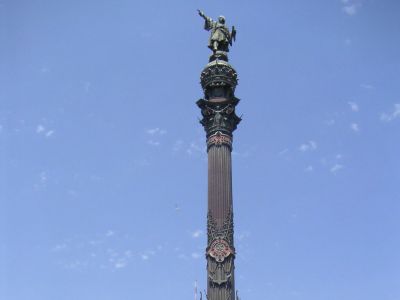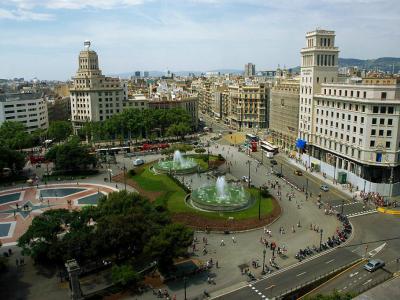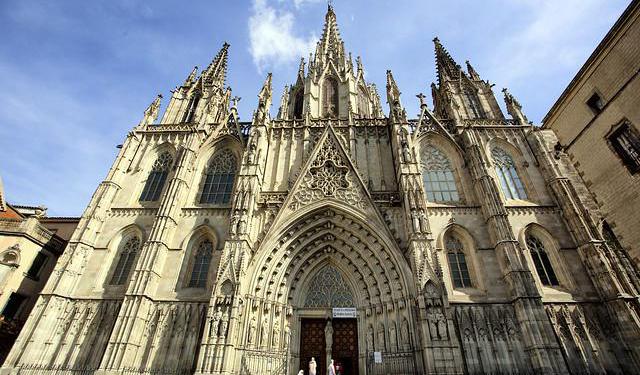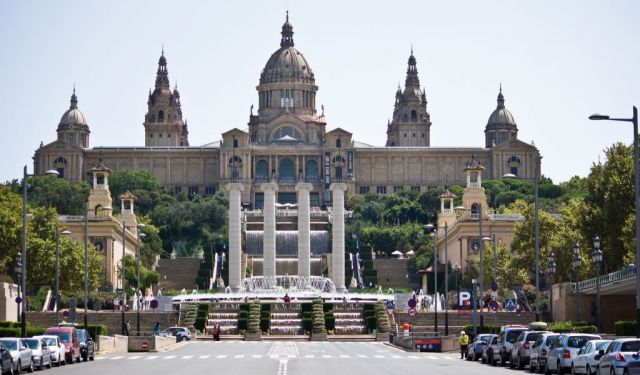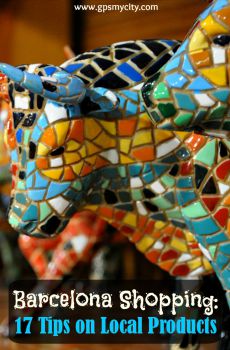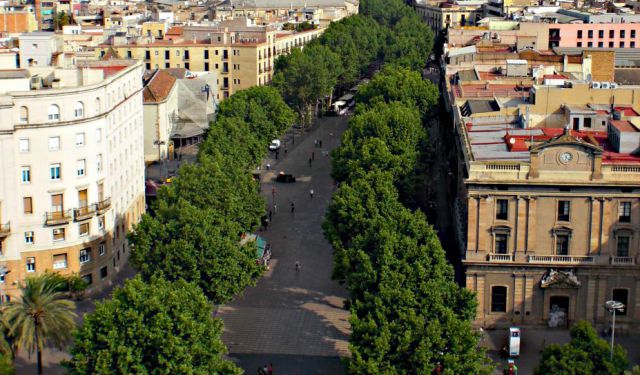
La Rambla Walking Tour (Self Guided), Barcelona
One of the main streets in central Barcelona, La Rambla is popular with tourists and locals alike. Connecting the city’s old port with Plaça de Catalunya, it is filled with cultural and historic landmarks, as well as many terraces, restaurants, shops and street artists. Spanish poet, Federico García Lorca once said it was “the only street in the world which I wish never ended.”
Start your tour from the historic Columbus Monument at the shoreline – a wonderful place for walking, on a street lined with palms trees facing the sea. From there, head to the Maritime Museum, located inside the Barcelona Royal Shipyard, which is over 700 years old. Its star attraction: A full-size replica of the Royal Galley, built in 1568 and formerly part of the Fleet of the Holy League. The best bit, without a doubt, is that you can actually walk onto it!
Fancy other fun diversions? The recently renovated Barcelona Wax Museum is cozy and doesn't feel at all institutional, encouraging visitors to get up close and take photos with the waxworks. New installations such as the hurtling glass elevator and the interactive corridor are brilliant. You can learn something, too, but the educational touch is very light, with a much greater emphasis on an enjoyable experience.
Be prepared to see quite a few interesting toys at the Erotic Museum – a place that shares a bit of information about the history of sex from early times until modern days. Antoni Gaudi’s Guell Palace is also definitely worth visiting, especially if you're into exquisite Gothic architecture and the most dramatic, intricate interiors.
Interesting during the day, Plaça de Catalunya is prettier at dusk when the fountains are lighted, so make that your final stop as there are many perspectives for photo shoots, plus loads of shopping and eating to be experienced in the surroundings.
Take this self-guided walking tour to explore the most famous sites on Barcelona’s La Rambla!
Start your tour from the historic Columbus Monument at the shoreline – a wonderful place for walking, on a street lined with palms trees facing the sea. From there, head to the Maritime Museum, located inside the Barcelona Royal Shipyard, which is over 700 years old. Its star attraction: A full-size replica of the Royal Galley, built in 1568 and formerly part of the Fleet of the Holy League. The best bit, without a doubt, is that you can actually walk onto it!
Fancy other fun diversions? The recently renovated Barcelona Wax Museum is cozy and doesn't feel at all institutional, encouraging visitors to get up close and take photos with the waxworks. New installations such as the hurtling glass elevator and the interactive corridor are brilliant. You can learn something, too, but the educational touch is very light, with a much greater emphasis on an enjoyable experience.
Be prepared to see quite a few interesting toys at the Erotic Museum – a place that shares a bit of information about the history of sex from early times until modern days. Antoni Gaudi’s Guell Palace is also definitely worth visiting, especially if you're into exquisite Gothic architecture and the most dramatic, intricate interiors.
Interesting during the day, Plaça de Catalunya is prettier at dusk when the fountains are lighted, so make that your final stop as there are many perspectives for photo shoots, plus loads of shopping and eating to be experienced in the surroundings.
Take this self-guided walking tour to explore the most famous sites on Barcelona’s La Rambla!
How it works: Download the app "GPSmyCity: Walks in 1K+ Cities" from Apple App Store or Google Play Store to your mobile phone or tablet. The app turns your mobile device into a personal tour guide and its built-in GPS navigation functions guide you from one tour stop to next. The app works offline, so no data plan is needed when traveling abroad.
La Rambla Walking Tour Map
Guide Name: La Rambla Walking Tour
Guide Location: Spain » Barcelona (See other walking tours in Barcelona)
Guide Type: Self-guided Walking Tour (Sightseeing)
# of Attractions: 8
Tour Duration: 1 Hour(s)
Travel Distance: 2.3 Km or 1.4 Miles
Author: clare
Sight(s) Featured in This Guide:
Guide Location: Spain » Barcelona (See other walking tours in Barcelona)
Guide Type: Self-guided Walking Tour (Sightseeing)
# of Attractions: 8
Tour Duration: 1 Hour(s)
Travel Distance: 2.3 Km or 1.4 Miles
Author: clare
Sight(s) Featured in This Guide:
- Mirador de Colom (Columbus Monument)
- Museu Maritim de Barcelona (Maritime Museum)
- Museu de Cera (Barcelona Wax Museum)
- Palau Guell (Guell Palace)
- Mercat de la Boqueria (La Boqueria Market)
- Museu de l'Erotica (Erotic Museum)
- Palau de la Virreina (Virreina Palace)
- Placa de Catalunya (Catalonia Square)
1) Mirador de Colom (Columbus Monument)
Designed by Gaietà Buigas for the 1888 Universal Exhibition, the Columbus Monument stands at the base of La Rambla, symbolizing the Catalans' recognition of Christopher Columbus as one of their own, despite his Italian origins. Atop the monument, a striking bronze statue of the explorer, sculpted by Rafael Atché, captures attention. Originally intended to face west towards the Americas, it now points east, either towards Columbus's birthplace of Genoa, Italy, or simply striking a dramatic pose. Inscribed with the word "Tierra" (land), the statue stands above a series of intricate sculpted images depicting significant moments from Columbus's journey to the Americas, including encounters with native people, notable locations, and his meeting with King Ferdinand and Queen Isabella of Spain.
Venturing inside the monument, visitors can take a lift to reach a viewing platform at its pinnacle, offering breathtaking panoramic views of the city. Upon returning to the ground, wine enthusiasts can indulge in a tasting experience within the monument's cellar. A combined ticket for both the lift ride and wine tasting can be obtained at the base of the monument.
Tip:
Take the time to go around the monument and take in its sculptures showcased at the base, while also discovering the wine bar and a boutique offering unique souvenirs and gifts that surpass the mass-produced items found at street vendors. To further enhance your experience, ascend to the viewing platform via an elevator, where you can enjoy a sweeping view of the surrounding area. Please note that an admission fee is required for access to the platform.
Viewing Platform:
Daily: 8:30am–2:30pm
Venturing inside the monument, visitors can take a lift to reach a viewing platform at its pinnacle, offering breathtaking panoramic views of the city. Upon returning to the ground, wine enthusiasts can indulge in a tasting experience within the monument's cellar. A combined ticket for both the lift ride and wine tasting can be obtained at the base of the monument.
Tip:
Take the time to go around the monument and take in its sculptures showcased at the base, while also discovering the wine bar and a boutique offering unique souvenirs and gifts that surpass the mass-produced items found at street vendors. To further enhance your experience, ascend to the viewing platform via an elevator, where you can enjoy a sweeping view of the surrounding area. Please note that an admission fee is required for access to the platform.
Viewing Platform:
Daily: 8:30am–2:30pm
2) Museu Maritim de Barcelona (Maritime Museum)
Barcelona's maritime museum is housed in the impressive Gothic Royal Shipyards ("Reials Drassanes"), a significant relic from the city's maritime empire that lasted well into the 18th century. After undergoing extensive renovations in 2016, the museum now features a new entrance from Plaça Portal de la Pau and large windows that flood the space with natural light, along with brand-new facilities throughout.
The 13.5-meter high hall now includes a metal sculpture of a whale and a vibrant painting by renowned artist Xavier Mariscal. Visitors can explore a range of fascinating exhibits, including a full-scale replica of Don Juan de Austria's flagship from the 16th century, traditional fishing vessels, antique navigation charts, dioramas depicting the Barcelona waterfront, and a life-sized replica of the Ictíneo I, one of the world's earliest submarines invented by Catalan polymath Narcís Monturiol in 1858.
With a regularly changing schedule of up to eleven temporary exhibitions, there is always something new to explore. Additionally, the museum provides a variety of activities, including navigation workshops and stargazing sessions, which can be booked through their website. As an added bonus, the museum entry ticket includes a short tour of the Santa Eulàlia – a beautiful vintage three-masted schooner docked at the picturesque Moll de la Fusta harbourside – and there is a delightful courtyard café where one can enjoy a peaceful hour or two.
The 13.5-meter high hall now includes a metal sculpture of a whale and a vibrant painting by renowned artist Xavier Mariscal. Visitors can explore a range of fascinating exhibits, including a full-scale replica of Don Juan de Austria's flagship from the 16th century, traditional fishing vessels, antique navigation charts, dioramas depicting the Barcelona waterfront, and a life-sized replica of the Ictíneo I, one of the world's earliest submarines invented by Catalan polymath Narcís Monturiol in 1858.
With a regularly changing schedule of up to eleven temporary exhibitions, there is always something new to explore. Additionally, the museum provides a variety of activities, including navigation workshops and stargazing sessions, which can be booked through their website. As an added bonus, the museum entry ticket includes a short tour of the Santa Eulàlia – a beautiful vintage three-masted schooner docked at the picturesque Moll de la Fusta harbourside – and there is a delightful courtyard café where one can enjoy a peaceful hour or two.
3) Museu de Cera (Barcelona Wax Museum)
It would take a truly unyielding spirit to resist the amusement offered by the city's wax museum. Housed within an elegant 19th-century bank building, this museum unveils a series of increasingly absurd scenes in its vast halls and dimly lit corridors. These tableaux portray recitals, meetings, and social gatherings featuring a peculiar and somewhat twisted ensemble of characters, ranging from Hitler to Princess Diana (detailed information on the lives of these personalities is also provided). Needless to say, the experience is highly entertaining, reaching its climax with cheesy underwater tunnels, space capsules, and an unsettling "Terror Room." Even if this doesn't pique your interest, it is unquestionably worth peeking into the museum's extraordinary grotto café/bar, known as El Bosc de les Fades. This enchanted "forest" is adorned with magically illuminated gnarled trees and gnomes, creating an otherworldly ambiance.
4) Palau Guell (Guell Palace) (must see)
Nestled in a discreet corner just off the bustling La Rambla, Antoni Gaudí's inaugural masterpiece in Barcelona swiftly propelled him to international acclaim for his remarkable and innovative architecture. Constructed in 1889 for the magnate Eusebi Güell, who became Gaudí's lifelong patron, the building stands out for its unconventional approach of showcasing iron supports as decorative elements, with intricately shaped and twisted columns, arches, and ceilings that would come to define Gaudí's future creations, culminating in a whimsical array of tiled chimneys on the roof terrace.
With no budget constraints set by Güell, Gaudí spared no expense, utilizing the finest materials and craftsmen. The central room on the main floor stands out as a remarkable feature, soaring three floors high and crowned with a cupola. Hidden within the ornate walls and ceiling are small observation holes, allowing the owner to discreetly observe guests from the upper floor before personally greeting them. The grand oval gates at the entrance, adorned with intricate ironwork resembling seaweed, provided direct access for high-society guests arriving in carriages, leading them to the horse stables located in the basement. From there, they could ascend to the upper floors.
Why You Should Visit:
Being slightly tucked away from the renowned La Rambla, this lesser-known gem attracts fewer tourists, offering a delightful opportunity to admire Gaudí's work in the charming old quarter of the city, while also saving time.
Tip:
The highlight here is the rooftop terrace and its colorful chimneys adorned with mosaic and broken tiles, each one unique. Take note that on rainy days, the rooftop may be closed, so it's advisable to check the weather forecast beforehand to ensure a pleasant visit.
With no budget constraints set by Güell, Gaudí spared no expense, utilizing the finest materials and craftsmen. The central room on the main floor stands out as a remarkable feature, soaring three floors high and crowned with a cupola. Hidden within the ornate walls and ceiling are small observation holes, allowing the owner to discreetly observe guests from the upper floor before personally greeting them. The grand oval gates at the entrance, adorned with intricate ironwork resembling seaweed, provided direct access for high-society guests arriving in carriages, leading them to the horse stables located in the basement. From there, they could ascend to the upper floors.
Why You Should Visit:
Being slightly tucked away from the renowned La Rambla, this lesser-known gem attracts fewer tourists, offering a delightful opportunity to admire Gaudí's work in the charming old quarter of the city, while also saving time.
Tip:
The highlight here is the rooftop terrace and its colorful chimneys adorned with mosaic and broken tiles, each one unique. Take note that on rainy days, the rooftop may be closed, so it's advisable to check the weather forecast beforehand to ensure a pleasant visit.
5) Mercat de la Boqueria (La Boqueria Market) (must see)
Located to the north of La Rambla and a couple of blocks south of Catalonia Square, La Boqueria Market is extremely busy no matter what time you go. Despite the constant flow of visitors, the experienced vendors efficiently handle the crowds, and the market's spacious layout helps ensure an enjoyable shopping experience.
With its rich history dating back to 1217, when meat stalls were first set up near the old city gate, La Boqueria offers a fantastic opportunity to explore traditional Catalan cuisine, take yourself on a tapas tour, sample exquisite jamón with cheese, purchase the world's freshest saffron (sold in various-sized small boxes) and seafood (no fish Sundays and Mondays), and discover culinary souvenirs. Don't miss the chance to try the freshly cooked fish at Kiosko Universal (a sit-down counter/bar-like place) or indulge in the wide variety of olives and delicious fresh fruits.
Venture deep into the market to find the best stalls and try a little of everything – you won't be disappointed.
Tip:
Keep in mind that the area is known for pickpocketing incidents, so whether you're alone or with friends, it's recommended to be vigilant and keep a close eye on your belongings.
With its rich history dating back to 1217, when meat stalls were first set up near the old city gate, La Boqueria offers a fantastic opportunity to explore traditional Catalan cuisine, take yourself on a tapas tour, sample exquisite jamón with cheese, purchase the world's freshest saffron (sold in various-sized small boxes) and seafood (no fish Sundays and Mondays), and discover culinary souvenirs. Don't miss the chance to try the freshly cooked fish at Kiosko Universal (a sit-down counter/bar-like place) or indulge in the wide variety of olives and delicious fresh fruits.
Venture deep into the market to find the best stalls and try a little of everything – you won't be disappointed.
Tip:
Keep in mind that the area is known for pickpocketing incidents, so whether you're alone or with friends, it's recommended to be vigilant and keep a close eye on your belongings.
6) Museu de l'Erotica (Erotic Museum)
Barcelona is renowned for its collection of peculiar artworks and museums, and among them stands the Erotic Museum situated on La Rambla. This unique establishment offers a surprisingly extensive exploration of erotic history, focusing on both the educational and recreational facets of human sexuality—an enduring theme that transcends cultures and races throughout history.
Within the museum, visitors can delve into the diverse manifestations of eroticism across different societies. Literature, illustrations, artworks, and even archaeological discoveries serve as mediums to showcase the evolution of eroticism in various cultures. With over 800 artifacts predominantly sourced from Rome and Greece, the museum provides a comprehensive understanding of the rituals, religious beliefs, and leisurely aspects associated with eroticism.
Operating until midnight, the museum offers translations in multiple languages and the option of themed guided tours. It's an experience that, as expected, leaves little to the imagination while maintaining a tasteful and enjoyable atmosphere.
Within the museum, visitors can delve into the diverse manifestations of eroticism across different societies. Literature, illustrations, artworks, and even archaeological discoveries serve as mediums to showcase the evolution of eroticism in various cultures. With over 800 artifacts predominantly sourced from Rome and Greece, the museum provides a comprehensive understanding of the rituals, religious beliefs, and leisurely aspects associated with eroticism.
Operating until midnight, the museum offers translations in multiple languages and the option of themed guided tours. It's an experience that, as expected, leaves little to the imagination while maintaining a tasteful and enjoyable atmosphere.
7) Palau de la Virreina (Virreina Palace)
Just past the Mare de Déu de Betlem church, the pavement recedes, revealing a magnificent view of the Palau de la Virreina. This grand rococo building boasts intricate stonework and ornate metal decorations. Originally completed in 1777 for Manuel Amat, the pleasure-seeking viceroy of Spain in Peru, it earned its name, the "Palace of the Viceroy's Wife", as his widow resided here for many years after his untimely death. Don't miss the palace's entrance and the meticulously carved floral designs adorning the pediments.
Constructed with two courtyards, the building is now known as the Virreina Centre de la Imatge. It serves as a cultural hub, hosting various events and exhibitions centered around contemporary art, film, and photography. At the building's front, you'll find a box office where you can obtain information and last-minute tickets for concerts, theater performances, dance shows, gallery exhibitions, and museum visits. If you venture to the courtyard's rear, you'll often catch a glimpse of the city's colossal Carnival giants ("gegants"), depicting the 13th-century Catalan king Jaume I and his wife, Violant. The origin of these elaborate five-meter-tall figures remains uncertain, but they likely originated from medieval traveling fairs and have become an integral part of Barcelona's festival processions.
Tip:
Adjacent to the palace stands the charming Casa Beethoven, a Modernista building that has been selling sheet music since 1920.
Constructed with two courtyards, the building is now known as the Virreina Centre de la Imatge. It serves as a cultural hub, hosting various events and exhibitions centered around contemporary art, film, and photography. At the building's front, you'll find a box office where you can obtain information and last-minute tickets for concerts, theater performances, dance shows, gallery exhibitions, and museum visits. If you venture to the courtyard's rear, you'll often catch a glimpse of the city's colossal Carnival giants ("gegants"), depicting the 13th-century Catalan king Jaume I and his wife, Violant. The origin of these elaborate five-meter-tall figures remains uncertain, but they likely originated from medieval traveling fairs and have become an integral part of Barcelona's festival processions.
Tip:
Adjacent to the palace stands the charming Casa Beethoven, a Modernista building that has been selling sheet music since 1920.
8) Placa de Catalunya (Catalonia Square)
As well as serving as the most connected transit hub for Barcelona's metropolitan area, Catalonia Square is "the heart of the city" in a wider sense. Undoubtedly one of the busiest and vibrant locations, it acts as a starting point for Barcelona's main arteries, such as La Rambla, the Gràcia Boulevard, and the Angel's Gate ("Portal de l'Àngel"). It's also the connection point between the Old City and its gridded 19th-century extension known as Eixample, which is home to some of Europe's most exquisite architecture.
As one of the largest and most bustling squares in Spain, Plaça de Catalunya is teeming with endless restaurants, hotels, shops, cafes, and entertainment venues, making it a vibrant place to explore. In the center of the square, you'll find pavement stones arranged in the shape of a star, which is believed to mark the center of the Catalonian capital.
For high fashion, design, jewelry and department stores, the principal shopping axis starts here – so if you're in for some retail therapy, this is the place to go. An initial orientation point for visitors is the white-faced El Corte Inglés, Spain's only surviving department store, a colossal fortress-like behemoth that houses everything you would expect – from books, music and food to high fashion, jewelry, technology, and homeware. The store is famous for its decent customer service, but also the 9th-floor cafeteria where you can get a seat by the window and enjoy a panoramic view over the square below. On the opposite side is El Triangle, a commercial center that is home to FNAC, a mega media store with several slick floors of books, music, and technology.
The square is also known for its fountains and statues, attracting flocks of tourists and pigeons in their thousands. As the afternoon progresses, it gets increasingly crowded and colorful, perfect to get a sense of life in Barcelona as there are always lots and lots of details to observe.
Tip:
While the fountains are beautiful during the day, make sure to witness their display at night when they come alive with alternating colored lights.
As one of the largest and most bustling squares in Spain, Plaça de Catalunya is teeming with endless restaurants, hotels, shops, cafes, and entertainment venues, making it a vibrant place to explore. In the center of the square, you'll find pavement stones arranged in the shape of a star, which is believed to mark the center of the Catalonian capital.
For high fashion, design, jewelry and department stores, the principal shopping axis starts here – so if you're in for some retail therapy, this is the place to go. An initial orientation point for visitors is the white-faced El Corte Inglés, Spain's only surviving department store, a colossal fortress-like behemoth that houses everything you would expect – from books, music and food to high fashion, jewelry, technology, and homeware. The store is famous for its decent customer service, but also the 9th-floor cafeteria where you can get a seat by the window and enjoy a panoramic view over the square below. On the opposite side is El Triangle, a commercial center that is home to FNAC, a mega media store with several slick floors of books, music, and technology.
The square is also known for its fountains and statues, attracting flocks of tourists and pigeons in their thousands. As the afternoon progresses, it gets increasingly crowded and colorful, perfect to get a sense of life in Barcelona as there are always lots and lots of details to observe.
Tip:
While the fountains are beautiful during the day, make sure to witness their display at night when they come alive with alternating colored lights.
Walking Tours in Barcelona, Spain
Create Your Own Walk in Barcelona
Creating your own self-guided walk in Barcelona is easy and fun. Choose the city attractions that you want to see and a walk route map will be created just for you. You can even set your hotel as the start point of the walk.
La Ribera Walking Tour
La Ribera is a culturally rich, historic area of Barcelona’s Old Town; somewhat less touristy than the Gothic Quarter (which one should really visit as well) and quite unspoiled, authentic and pretty. Centuries ago, it was a very well-to-do neighborhood inhabited by aristocrats, merchants, wealthy sailors, and Jewish money-lenders. Today, it is regarded as the Soho of Barcelona – a popular... view more
Tour Duration: 2 Hour(s)
Travel Distance: 2.8 Km or 1.7 Miles
Tour Duration: 2 Hour(s)
Travel Distance: 2.8 Km or 1.7 Miles
Gothic Quarter Walking Tour
A walk around the Gothic Quarter is a journey through time to Barcelona’s oldest history, going back to times of Roman rule; in fact, the typically Roman grid plan is still visible today in the quarter's layout. Only a few roads are open for car traffic, so there will be little in the way of enjoying the many narrow, atmospheric streets filled with superb food, high-quality architecture,... view more
Tour Duration: 2 Hour(s)
Travel Distance: 1.8 Km or 1.1 Miles
Tour Duration: 2 Hour(s)
Travel Distance: 1.8 Km or 1.1 Miles
Barcelona Introduction Walking Tour
According to legend, Barcelona was founded by mythological Greek hero Hercules on one of his expeditions, when his boats were hit by a storm. The first 8 boats managed to escape without damage, but the 9th one was lost at sea. Hercules found his lost friends some days later on the coast, all safe and sound. The crew was taken by the beauty of the coastal landscape, and so they decided to stay. It... view more
Tour Duration: 3 Hour(s)
Travel Distance: 5.7 Km or 3.5 Miles
Tour Duration: 3 Hour(s)
Travel Distance: 5.7 Km or 3.5 Miles
Montjuic Walking Tour
Montjuic is a hill in Barcelona which offers a variety of great attractions of historic, cultural, and architectural value. Here, you can watch a spectacular water show at the Magic Fountain of Montjuic, visit the place where matadors faced the bulls in the past, and explore the ancient Montjuic Castle with its breathtaking views.
A convenient start point, Placa d'Espanya is the second... view more
Tour Duration: 3 Hour(s)
Travel Distance: 5.0 Km or 3.1 Miles
A convenient start point, Placa d'Espanya is the second... view more
Tour Duration: 3 Hour(s)
Travel Distance: 5.0 Km or 3.1 Miles
Barcelona Food Tasting Walking Tour
No one should visit Barcelona without making an attempt to get acquainted with some of Spain’s best food – Catalan food. An abundance of fresh fish and superb meat, a plethora of great vegetables, plus local inventiveness, have produced a very diverse, distinctive and delicious cuisine, including the famous (and trendy) tapas dishes.
Follow this self-guided walk to treat your taste buds in... view more
Tour Duration: 2 Hour(s)
Travel Distance: 2.9 Km or 1.8 Miles
Follow this self-guided walk to treat your taste buds in... view more
Tour Duration: 2 Hour(s)
Travel Distance: 2.9 Km or 1.8 Miles
Picasso's Barcelona Walking Tour
Pablo Picasso – the great Spanish painter and sculptor – developed his style in Barcelona where he spent the formative years of his life, from the ages of 14 to 23. It is said that when the master spoke nostalgically of home, he actually meant the Catalonian capital, despite having been born in Malaga.
This self-guided walk will take you to the Picasso Museum, the bar-restaurant and the art... view more
Tour Duration: 2 Hour(s)
Travel Distance: 4.2 Km or 2.6 Miles
This self-guided walk will take you to the Picasso Museum, the bar-restaurant and the art... view more
Tour Duration: 2 Hour(s)
Travel Distance: 4.2 Km or 2.6 Miles
Useful Travel Guides for Planning Your Trip
Top 10 Spanish Foods and Drinks to Try in Barcelona
In the countries like Spain, food is a national heritage and cultural attraction in its own right. The latter is even more true of Catalonia in general and Barcelona in particular. Presented here are the 10 staples of Catalan food tradition, missing which would be a gastronomical...
Barcelona Souvenir Shopping: 17 Uniquely Spanish Things to Buy
Spain, in general, and Barcelona, in particular, are a treasure trove of all things exciting. Set your foot in Barcelona and you'll be spoiled for the choice of things worth trying and taking home. Before your head starts spinning, check this guide out to put yourself in the right...
10 Sightseeing Walks During Covid-19
Borders closed, flights canceled. As countries across the globe scrambling to curb the spread of coronavirus, it is nearly impossible to travel these days. For those with wanderlust at heart, living without exploring is a really tough challenge.
But even in times of hardship like this, one should...
The Most Popular Cities
/ view all
